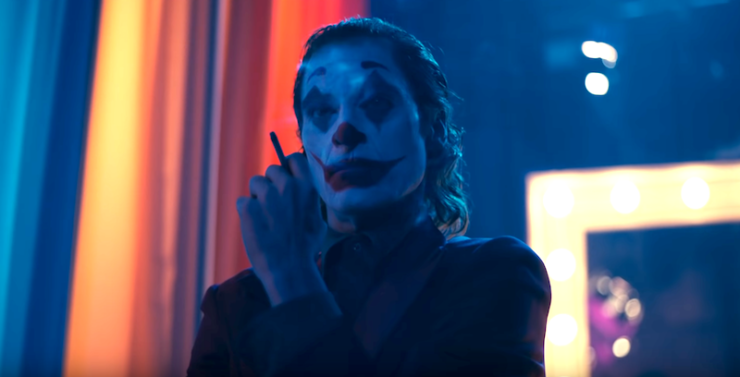As the song goes, “Everybody Loves A Clown”… Well, everybody except the Batman. And all the Robins. And the GCPD. And Gotham City. But the clown keeps coming back, regardless of who wants him hanging around. He always will. The Joker is now starring in his own origin film, so audiences can have another glimpse at the Clown Prince of Crime. His legacy is nearly as old as Batman’s cape and cowl.
Questions surrounding the character’s enduring popularity have raged for decades, but his appeal perhaps isn’t so hard to reconcile when we note what separates him from other DC villains—namely, in a universe where all the bad guys build their personas on schticks, the Joker is a cipher. The clown getup stays the same, but who he is entirely depends on what the story requires.
Is there a reason why the Joker lends himself to a more flexible character interpretation than other villains? The most obvious answer is simple enough: That’s what happens when you’ve been around for the better part of a century. There’s no possible way to remain the same over that length of time, especially with a constant turnover of writers and actors bringing the character to life.
From his first comics appearance in 1940, the Joker was little more than a creative serial killer in costume, offing victims with a venom that gave them his perpetual grin. Once comics began issuing more kid-friendly content, the Joker’s character was tempered by a certain level of playfulness, but even that wasn’t enough to appease the Comics Code Authority, which emerged in the 1954 due to public panic over “the kids” and how popular entertainment was affecting them. With those rules set down, the Joker was forbidden from committing murder at all, and started to fade into the background—only to be resurrected by his very first live-action portrayal from Cesar Romero in 1966’s Batman television series.
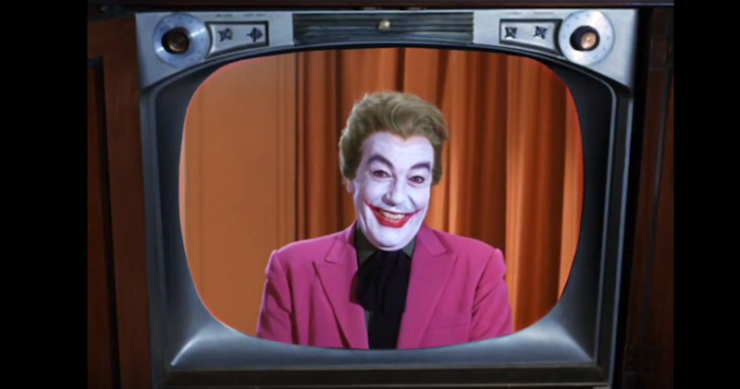
The swing of the Joker’s character from homicidal terror to goofy prankster to personification of chaos has always been a part of the character’s history, a needle that shifts position based on what seems popular at the time, and how readers (and viewers) respond to his antics. It’s arguable that the darker runs at the start of the Modern Era in comics tipped the scales permanently in favor of the Joker’s more malicious doings—The Dark Knight Returns, “A Death in the Family”, and The Killing Joke all had major bearing on the Joker’s more cemented position within the Batman canon—but other options have been explored. Batman: The Animated Series cast Mark Hamill in the role of the Joker, and the show did an excellent job of balancing a myriad of qualities the character was known for, allowing for menace and abuse alongside a more robust sense of humor and the occasional slapstick gambit. The character managed to fall somewhere in the middle in Jack Nicholson’s turn as well, equal parts gangster and sad clown, and a bit more mythic in his construction as the person who “made” Batman by virtue of killing Bruce Wayne’s parents.
Heath Ledger’s portrayal of the Joker hinged on bringing the more chaotic tendencies of the character front and center. In addition to considering himself Batman’s equal opposite, The Dark Knight’s Joker thrived on sowing discord amongst seemingly “good” people, whether it was encouraging Harvey Dent on his road to becoming Two-Face, or trying to get two ferries of Gotham citizens to blow each other up out of fear. He also deliberately kept his own origins a secret, always telling different stories around his prominent facial scars. In terms of genuine horror, Ledger’s version keyed into one of the most terrifying aspects of the Gotham’s Harlequin of Hate—his unpredictability. The fact that he managed to project a sheen of likability despite the horrors he perpetuated made his take one of the most compelling iterations of both the character, and any superhero villain to date. Then there was the erratic and bullying turn by Jared Leto in Suicide Squad, followed shortly by Joaquin Phoenix, who is currently occupying the role by bringing all the dour realism to the Joker that modern audiences seem hungry for of late.
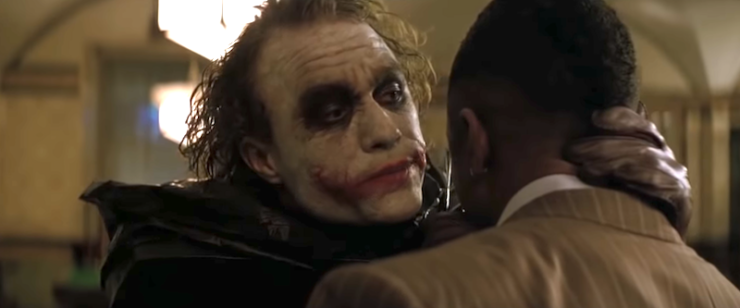
Then again, the “long arc, many iterations” answer might be too simple. After all, Batman has been around even longer than the Joker, and while the tones and trappings of his stories may change, the core of his character remains—a rich boy orphaned by violence who grows up and chooses to defend the city he loves, donning a bat costume to frighten criminals. For the most part, Batman’s rules and style guide stay intact: Kid sidekick, no-kill rule, detective and noir underpinnings, fake playboy status to keep people off his alter ego’s track. There are some vacillations, as not everyone enjoys the kid sidekicks and others prefer to show Bruce Wayne as a more active boss and leader in his family company, but Batman is Batman. Tone doesn’t really change the fundamental core of the character unless alternate universes are in play.
The Joker, on the other hand, adjusts to the needs of the narrative without ever realizing that he’s done it. Need a criminal? The Joker’s your guy. Need a mastermind behind all the awfulness in your city? He can manage that, too. Need a nightmare to haunt your every waking moment? He’s happy to help. Need an agent of random chance to push the plot into high gear, someone to scare the other villains, an idea for Batman or the audience to push back against? The Joker can (and has) done all these things. It’s easier to observe on screen, as rotating actors make the differences even more prominent, but he’s done the same through comics history as well. The Joker exists to facilitate narrative, and on some level, he’s abundantly aware of this—the character always displays a near-meta understanding of his relationships to old Batsy, and to Gotham City.
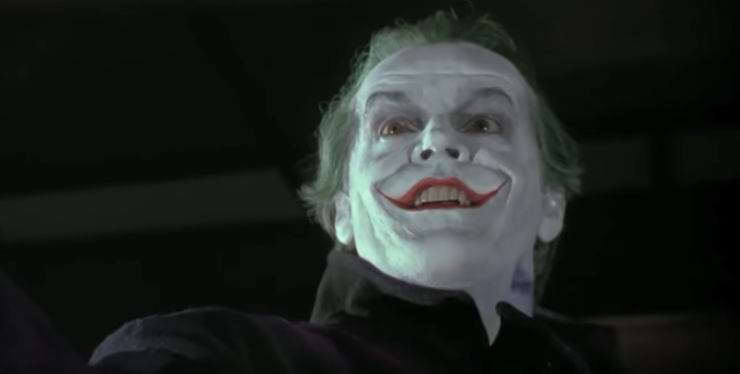
So maybe this is inherent to the character in some way? It’s a fair assumption… after all, clowns deal in chaos. The concept of the clown is couched in absurdity, taking a magnifying glass to the mundane and making a spectacle of it. It’s one thing that every iteration of the Joker has in common, in fact—whether it’s Cesar Romero orchestrating his prison break from a baseball diamond, Jack Nicholson defacing an art gallery, or Heath Ledger burning a giant pile of money, spectacle is the name of the game. The Joker deals in it, a currency made of shock and awe. Clowns are entertainers, which means that Gotham’s greatest criminal is a least partly in it for the applause, for the adoring eyes of an audience. And as the old saying goes “the hero gets the girl, but the heavy gets the notice.” That’s certainly proven true over the decades, or the Joker wouldn’t be the prize baddie for nearly every Batman story arc regardless of medium.
Or maybe it’s a bit more sinister than that. Maybe after all this time we, as readers and viewers, maybe we want this malleability to remain consistent in the character. Most of the villains in the Rogue’s Gallery are interesting in their own rights, but there’s something appealing about a figure who can be remodeled based on how we would prefer to be frightened. If there weren’t, we wouldn’t be staring down the opening weekend of Joker, which has already made so much money that a sequel could be well on the way. We’re engaged by the Joker because we enjoy when we can’t predict what he’ll do, how he’ll be written or performed—in a genre that can easily get riddled with clichés when it’s not careful, that’s a welcome respite from the same old super-charged punch-outs.
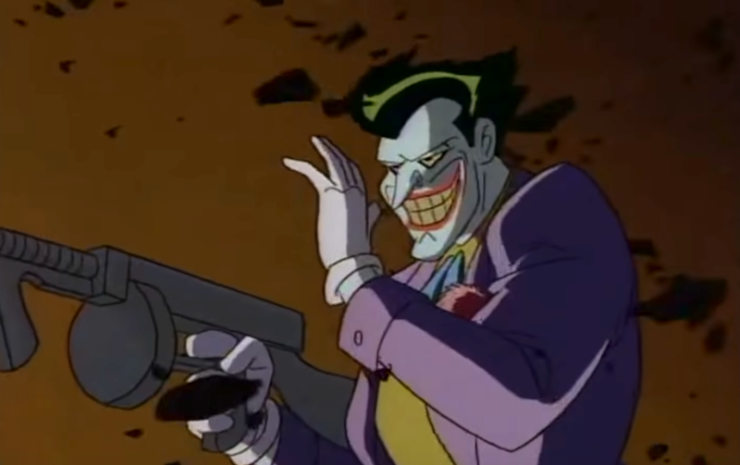
What does this say about a character whose tenure has spanned eight decades and counting, whose core nature is practically impossible to pin down? It’s clear that no matter the reason, the Joker’s flexibility has been his saving grace. Heroes come with rules, and so do most villains—they are created with purpose, pathos, codes and origins that inform how they behave and what they can do. The Joker engenders no such strict adherence and the reason is built into the veneer: A clown only needs to paint on a different face to change their character. In effect, the Joker is literally built to fit whatever story you’d prefer to tell (and even stories you’d prefer people didn’t tell). That’s the reason why everyone wants to try their hand in his creation. He can be anything you need him to be, and that makes him a formidable piece of the superhero toolkit, rather like the queen on a chessboard; he can move anywhere, however he chooses.
Is that a good thing? It can get grating seeing the same figures trotted out over and over again, no matter how effectively they are reimagined. Given our current bent toward reboots and sequels to nearly every franchise under the sun, this repetition will eventually get old, no matter how surprising or new the depictions seem. But it can be fascinating to examine what allows certain characters to withstand change and reinvention. In this case, the adage somehow remains true: Everybody does love a clown.
Or perhaps everyone is scared witless of them.
Emmet Asher-Perrin prefers the Mark Hamill version, though. You can bug him on Twitter, and read more of her work here and elsewhere.










